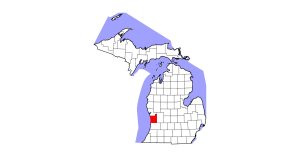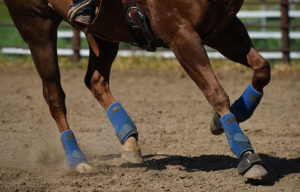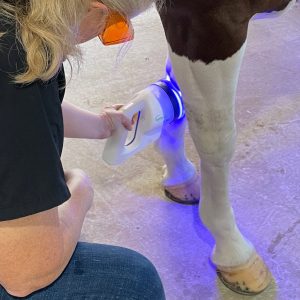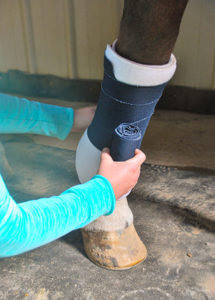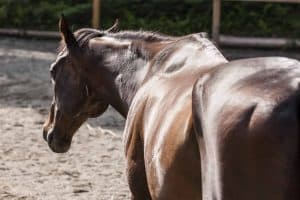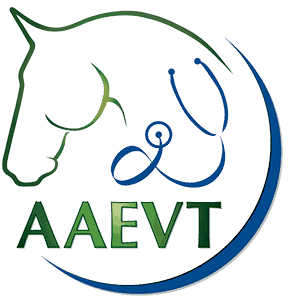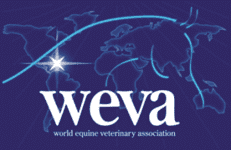How Feed Changes Affect the Horse’s GI Tract

Owners might find themselves making major adjustments to their horses’ forage when they’re moving between facilities, beginning to feed a new batch of hay, introducing pasture, etc. Though the horse industry has focused more on slow shifts in supplemental feed, equine nutritionists recommend slow changes for all aspects of nutrition—both commercial feeds and forages. Understanding the underlying physiology of the horse’s gastrointestinal (GI) tract can help owners recognize the importance of slow forage changes. Using equine-nutritionist-recommended methods for these shifts can reduce your horse’s risk of gastrointestinal upset.
Horses have a large population of microbial organisms living in their gastrointestinal tract, specifically the hindgut where fermentation takes place. “The horse’s digestive system is filled with millions/billions of microbial organisms, primarily in the hindgut but also to some degree in the foregut/stomach,” says Shannon Pratt-Phillips, MSc, PhD, professor of animal science at North Carolina State University, in Raleigh. “Therefore, we can think of the digestive tract as a micro-ecosystem from these microbes—and, just like any ecosystem, changes can be detrimental. So, by introducing feed changes slowly, we give those microbes time to adapt to new substrates.”
Indeed, even changes in forage can negatively impact the microbes in the horse’s gut. “The nutritional value of hay can vary greatly due to differences in maturity of cutting and species type, which ultimately affects the types of fibers that are predominant in the hay—hemicellulose, cellulose, lignin, or sugars and starches,” says Pratt-Phillips. When the horse’s digestive system is used to particular substrates, a rapid change could cause some microbes to die, which could have negative effects such as an increase in lactate production, which can lower the pH of the intestines, she adds. When this occurs in the gut, it can kill off large proportions of the microbes.
“Other issues can be damaging to the intestinal lining, making it leakier, which can cause colitis,” says Pratt-Phillips. “Some of the fermentation pathways can also create more gas production that could lead to discomfort, also referred to as (gas) colic.”
“Many horses are stoic and may seem unaffected by rapid dietary changes, but this doesn’t account for what is going on under the surface,” says Rachel Mottet, PhD, equine nutritionist, owner of Legacy Equine Nutrition, in Ocala, Florida. When you make sudden changes to your horse’s diet, one major concern is certain microbiota that are fermenting a particular fiber can become unsettled and shift suddenly, she adds. “These shifts in gut microbiota can be unfavorable and potentially result in events that lead to GI upset, colic, laminitis, or other health woes. This is why slow and steady is always best when it comes to equine dietary changes.”
When you know your horse’s nutrition will be changing, creating a plan can reduce the risk of gastrointestinal upset by mitigating the stress on the GI tract’s microbial population. Different forages contain varying nutritional values and can shock the microbes when abruptly switched. “While slow forage transitions when going from one barn to another often don’t happen, at the very least one can get a few days’ worth of hay that would be great for the purpose of mixing,” says Mottet.
“My general recommendation is to have (the first one to two days at a new facility) 100% the diet the horse was on previously,” notes Mottet. “Moving is extremely stressful for horses and when everything is changing rapidly, I would prefer the gut to be as stable as possible through that transition.” After the initial one to two days described, she recommends a week of mixing the two diets. If you can’t get hay from the previous barn, try to bring some concentrate with you to keep that consistent. Be sure to apply this tactic when you have a new batch of hay, as well, transitioning from the former batch to the new batch slowly.
For example, if your horse’s daily ration consists of both hay and concentrate, bring enough hay from the previous barn to sustain your horse for 4 or 5 days. For a horse that is about 1000 pounds, this would require 20 pounds of hay per day. Following Mottet’s recommendation, feed only this hay for the first two days, after which you would transition to feeding a mixture of equal parts hay from the previous barn with the hay at the new facility before weaning them off the old hay completely.
If the concentrate is also changing, use a similar approach. Feed the same products and amounts for the first few days, then as you decrease the amount of the original concentrate product, begin increasing the amount of the new concentrate in the ration until the horse is fully transitioned on to the new plan.
The equine gut microbiome is complex—there is a lot going on beneath the surface. Because horses are stoic prey animals, owners or farm managers might not easily notice gastrointestinal upsets until more serious issues such as colic arise. Because the microbial population becomes accustomed to the substrates provided in the diet, any changes cause disruption. Therefore, equine nutritionists recommend transitioning horses’ diets slowly, including implementing forage changes.

Written by:
Madeline Boast
Related Articles
Stay on top of the most recent Horse Health news with
